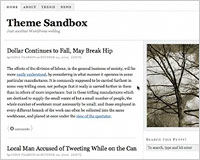 About two years ago, Chris Pearson's WordPress theme, Thesis, passed the $2 million mark in total sales.
About two years ago, Chris Pearson's WordPress theme, Thesis, passed the $2 million mark in total sales.
It's a remarkable achievement for a design-based product, particularly given the industry. Here is a theme-not a platform, but a theme-beating many of the world's leading independent design firms in revenue, all through passive sales.
This means that the design industry no longer offers only services, but also offers products to its own designers and developers.
While the industry has held many opportunities for work, a designer's pay has traditionally been based on hours rendered and total output. Pearson has achieved a breakthrough with this theme, cementing the immense value of design-based products.
The term "paradigm shift" is thrown around too often in business articles. But Thesis has truly changed the way designers view their work and allot their time.
Hundreds of developers are now productizing their work and creating assets that earn passive income for them, thus freeing up the time they have for other online projects.
I've studied Thesis to pinpoint the factors that have led to its success. From its flexible code to lucrative affiliate programs, there are eight main elements behind the theme's skyrocketing sales.
If you would like to replicate the theme's success as an online product, these eight observations would no doubt prove helpful.
1. Make Your Product Flexible and Versatile
Take one look at Thesis and you'll see why it's so popular. The theme is simple, flexible and versatile enough to work as part of any website. It's a classic do-all utility priced far below its actual value to most designers.
You could price a niche product as ludicrously as you like and still make a few sales. Buyers are waiting at any price range, no matter how niche the product.
But in order to market your theme to the thousands, you need to create something any designer would find value in. Versatility is a must: create something powerful that also appeals to a wide audience.
2. Use Effective, Clear and Tech-Based Marketing
Selling to designers is difficult, and selling to developers is even harder. Developers are used to building their own tools and coding their own themes.
Paying for something that they could create themselves does not seem right to them. Thesis beats this anti-spending mindset quite interestingly.
First, it uses a clear tech-based marketing message to capture the attention of designers. The theme is marketed on its simplicity and versatility, and it employs just the right amount of jargon to enamor developers.
Most products can't be marketed like this, but tools geared to a technical audience tend to sell better when built around concrete figures and technical features.
3. Understand Your Audience
 As an entrepreneurial developer, Chris Pearson understood the value of appealing to his audience.
As an entrepreneurial developer, Chris Pearson understood the value of appealing to his audience.
Unlike other developers who will use almost any channel to advertise their product, Chris Pearson relied on his audience to spread the word and make Thesis a smashing success.
He also provided a forum for support and formed a community, which made the theme central to the work of many WordPress developers.
Those looking to productize a service need to understand what their audience is looking for. The most effective WordPress themes sell because of fanatical support and fantastic service, as well as a large and influential developer community.
Create a product and a community resource that developers love and you'll have little trouble marketing the product.
4. Use an Affiliate Program
Affiliate programs are a mixed bag, particularly when it comes to design-based products. While the sales benefit of an affiliate program is big-particularly when backed by high commissions-you risk hurting your reputation.
Many affiliates resort to nasty tactics to push your product, and your name and company could wind up being associated with them.
These risks can be minimized by using a tightly controlled affiliate scheme. Thousands of copies of Thesis have been sold through affiliate programs. Indeed, affiliate sales make up the bulk of the revenue. It's truly an adapt-or-die scenario: to move even a small number of units, implementing an affiliate program is essential.
5. Avoid Tight Control
Pearson could have adopted Apple's approach by limiting the ways in which people could tinker with his product to improve usability and performance. It's an effective strategy for consumer-based products, but it's not the right way to market to engineers.
To sell a product like Thesis, which is highly flexible, immensely powerful and built for people who love to tinker with settings, the creator has to make it versatile and unrestricted.
Consider your audience: if it consists of designers, then make the product more competitive by allowing customers to tweak and modify it.
6. Design Products That Make Companies Rich
As a designer, your job is to capitalize on every opportunity. When a client spots a gap in the market or an opportunity online, you're the person they call. Fill this same role with your product. Your theme should help make other people rich.
Thesis does this by providing a simple framework for companies and marketers to build on. Other themes do it by giving companies a straightforward way to create a website. For your theme to sell even modestly, it needs to eliminate a barrier that's preventing companies from making money.
7. Exploit Your Theme to Market Other Products
Most designers are familiar with the concept of a sales funnel. The web developer offers a selection of additional services to the client after completing an order.
Designers of successful themes use a sales funnel to build on their success, leading clients to new products and premium services.
If you're going to release a product, consider its value as a cross-promotional tool. Many developers price their first product very affordably in the hope that it will enable them to collect email addresses, build a community and market future products.
8. Design for Businesses, Not Consumers
Most companies are willing to set aside a sizable budget for any service that will increase their revenue. They're happy to spend big on products that bring in new business, help them make more money or simplify an otherwise time-consuming (and thus expensive) process.
Thesis is positioned as a product that saves companies time. Position your theme as a product that helps companies, not consumers, and you'll gain access to a wide audience of people who don't mind spending money where it counts.
For more professional WordPress Themes, check out Elegant Themes
For more information about this theme go to the Thesis Website
Written exclusively for WDD by Mathew Carpenter. He is an 18-year-old business owner and entrepreneur from Sydney, Australia. Mathew is currently working on Sofa Moolah, a website that teaches you how to make money online. Follow Mathew on Twitter: @matcarpenter. Follow Sofa Moolah on Twitter: @sofamoolah.
What do you think of Thesis and its business approach? How do you market your own themes? Please share your views below...















